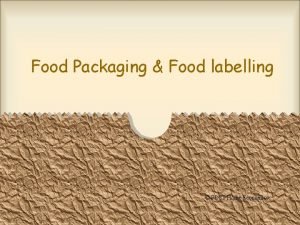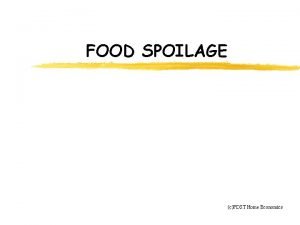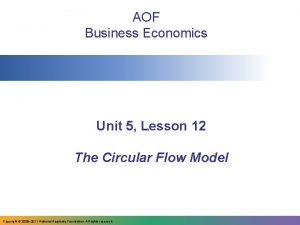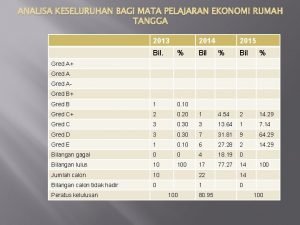Safety in the Home PDST Home Economics Reasons





























- Slides: 29

Safety in the Home © PDST Home Economics

Reasons for Accidents in the Home Careless/forgetful people, curious/active toddlers. Faulty equipment or wiring Badly constructed buildings Careless storage of harmful substances By chance

Most Common Accidents in the Home Burns/scalds Falls Cuts Poisoning Electrocution Choking/suffocation A fatal accident is where someone dies as a result

Preventing Falls Wipe up spills Do not over-polish floors. Rugs should have non-slip back Avoid trailing flexes Stairs – well lit Keep stairs clear Use stair gates with toddlers Avoid cluttered floors Use proper steps when reaching high shelves

Safety with Medicine Store in original container Keep in locked press out of reach of children Dispose of out of date medicine Never use medicine prescribed for one person for someone else.

Safety Symbols

Fire Safety Use fire guards Do not hang clothes near open fire Do not move portable heaters when lit Switch off and unplug electrical appliances at night, do not leave on standby Never put hot ashes in plastic bins Never smoke in bed Never leave chip pans unattended

Small Fire Use fire blanket or extinguisher to put out the fire. Never use water on electrical fire or oil/fat. Call fire brigade if unable to extinguish fire

Larger Fires Raise the alarm Get everyone out of the house closing windows and doors if possible Never re-enter burning building Call fire brigade

Fire safety equipment for the home Smoke alarms Fire guards Fire blanket Fire extinguisher

First Aid Aims of first aid: To preserve life. To prevent condition from worsening To reassure victim To provide comfort

In the case of a serious accident 1. Stay calm, act quickly 2. Call or get someone to call for emergency services. 3. Check if patient is conscious. 4. If unconscious check for breathing and pulse, use CPR if necessary.

In the case of a serious accident 1. If there is a pulse and breathing, check for bleeding and apply pressure to stop bleeding 2. Do not move the patient unless they are in danger. 3. Do not give patient anything to eat or drink. 4. Make patient comfortable, keep them warm and talk to them until help arrives.


First Aid for Burns and Scalds A burn is cause by dry heat, a scald is caused by moist heat e. g. hot liquid or steam. Minor 1. Submerge area in cool water until pain eases. 1. Spray with burn spray if you wish, do not apply lotion or ointment 1. Cover with sterile dressing Major burns/scalds If clothing is on fire, pour water on victim or wrap in blanket to extinguish the fire. Do not remove clothes that are stuck to the wound but cover any exposed areas with a clean dry cloth to stop infection. Treat for shock by raising victim’s legs and loosening any tight clothing. Cover to protect from heat los Get medical help

Burns & Scalds

Cuts If cut is deep with blood spurting from it, apply pressure to the cut with a clean pad and get medical help. For less serious cuts: Wash wound with warm water and antiseptic. Ensure that there is nothing embedded in the wound such as dirt or glass Dry carefully and cover with clean dressing If the wound is deep, it may need to be stitched by a doctor.


Nose Bleed 1. Lean forward 2. Squeeze the nostrils 3. Avoid blowing your nose for a while

Choking Caused by a blockage in the airways, victim cannot breath. First aid must be given quickly. Children: Place the child face down over your knees, support head with one hand Slap child 4 times between shoulder blades. Adults: Use Heimlich manoeuvre. Stand behind victim, clasp hands under rib cage, pull hands sharply in and upwards, repeat as necessary.


Falls If victim is unable to move: Do not move victim unless in danger. Cover and send for medical help. Strain or sprain Apply cold compress to area for 30 mins, reduce swelling. Dry and wrap in bandage, rest and elevate. If in doubt treat as fracture


Fainting Anyone feeling faint should sit down and lean forward so that their head is between their knees. If person has already fainted they should remain lying down for 10 mins. before standing again If a person fails to regain consciousness within 2 minutes get medical help.


Poisoning 1. If substance has been swallowed bring patient to hospital immediately 2. Bring also the container of the substance was in. 3. If victim is unconscious, place him in recovery position and call ambulance 4. If you are sure what the person has taken is not corrosive, make the victim vomit and bring a sample of the vomit to the hospital 5. If poison is corrosive, do not induce vomiting, give milk to neutralise

Stings Bee Stings – Bread Soda Wasp stings Vinegar

First aid box Well stocked Conveniently placed Out of reach of children Clean and tidy Antiseptic Cotton wool Scissors Plasters Sterile bandage Sterile dressing Burn-spray Safety pins Thermometer Tweezers Surgical gloves

First aid kit
 Pdst home economics
Pdst home economics Pdst home economics
Pdst home economics Pdst home economics
Pdst home economics Pdst economics
Pdst economics She said that, home economics stands for the ideal home.
She said that, home economics stands for the ideal home. Report writing pdst
Report writing pdst Ciara o'donnell pdst
Ciara o'donnell pdst Pdst ipo
Pdst ipo Lcvp summary report example
Lcvp summary report example Www.pdst.ie
Www.pdst.ie Maastricht university school of business and economics
Maastricht university school of business and economics Mathematical economics vs non mathematical economics
Mathematical economics vs non mathematical economics 1950s home economics textbook
1950s home economics textbook Reasons for food spoilage
Reasons for food spoilage Economics unit 5 lesson 10
Economics unit 5 lesson 10 Home economics subjects
Home economics subjects Hát kết hợp bộ gõ cơ thể
Hát kết hợp bộ gõ cơ thể Ng-html
Ng-html Bổ thể
Bổ thể Tỉ lệ cơ thể trẻ em
Tỉ lệ cơ thể trẻ em Gấu đi như thế nào
Gấu đi như thế nào Chụp tư thế worms-breton
Chụp tư thế worms-breton Chúa sống lại
Chúa sống lại Môn thể thao bắt đầu bằng chữ đua
Môn thể thao bắt đầu bằng chữ đua Thế nào là hệ số cao nhất
Thế nào là hệ số cao nhất Các châu lục và đại dương trên thế giới
Các châu lục và đại dương trên thế giới Công thức tiính động năng
Công thức tiính động năng Trời xanh đây là của chúng ta thể thơ
Trời xanh đây là của chúng ta thể thơ Mật thư anh em như thể tay chân
Mật thư anh em như thể tay chân Phép trừ bù
Phép trừ bù



















































